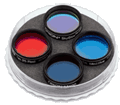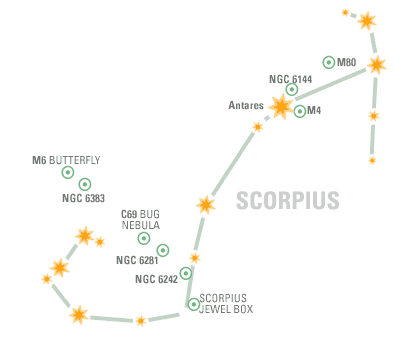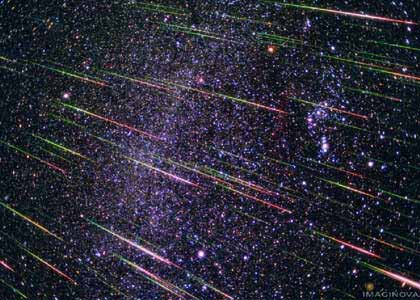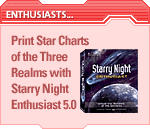 |
||||||||||||||||||||||||||||||||||||||||||||||||||||||||
|
If you have trouble viewing this newsletter, click here. Welcome again to our monthly newsletter with features on exciting celestial events, product reviews, tips & tricks, and a monthly sky calendar. We hope you enjoy it!
There are three “realms” to explore with your telescope. The first is sometimes called the shallow sky: our solar system, including the Sun, Moon, planets, asteroids, and comets. The second is what I call the starry realm: the stars in the immediate neighborhood of our Sun, which make up the familiar patterns of the constellations we see on any clear night. These include double and multiple stars, and variable stars. The third realm is usually called the deep sky: star clusters and nebulae within our own galaxy (the Milky Way), the cloud of globular clusters which orbit around our galaxy, and the countless number of galaxies beyond our Milky Way. All three realms can be studied with any telescope. The Shallow Sky The easiest realm for the beginner to explore is that of our own solar system. The Moon is probably the first object at which most people look. It is easy to find, and reveals a rich surface to explore with any scope at any magnification. I usually recommend a Barlow for beginners as it immediately doubles the number of magnifications available with any telescope. It’s worth spending a little extra and getting a good quality Barlow, such as the Orion Shorty Plus. Using the example of the SkyQuest XT6, the standard 25mm and 10mm eyepieces will yield 96x and 240x respectively when used with the Shorty Plus. I’ve found 240x to be the “just right” magnification for the Moon. The best time to observe the Moon is while it’s in its partial phases, because the surface features cast long shadows emphasizing their relief. Full Moon, while pretty to look at, is rather like the desert at high noon: no shadows, so no three-dimensional effects.
Some people find the Moon painfully bright to look at through the telescope. One way to handle this is with a Moon filter such as the Orion Neutral-Density Moon Filter; this will reduce the glare to a comfortable level. Another way is to light up the area where your telescope is located, since the Moon only seems bright because we are viewing it from a dark location in a dark sky. Even using a white flashlight will help a lot. Using a magnification over 200x also cuts the brightness. The planets are another set of popular targets for amateur astronomers. Beginners often have a hard time spotting them, since they look much like bright stars to the naked eye. A telescope will soon reveal the difference: all the stars in the sky, no matter how large or bright, are so far away from us that they all appear as points of light. All the bright planets immediately show disks even at low magnifications. Venus and Mercury are always close to the Sun, so are mainly visible at sunset and sunrise; neither shows much in the way of surface detail, but will show a clear phase similar to the phases of the Moon. Mars is reddish in color and shows a small disk. Again a magnification of 200x or more is necessary.
Jupiter is probably the most rewarding planet for the amateur. A higher magnification will reveal at least two dark cloud belts on the disk of Jupiter and, if you are lucky, you may catch a glimpse of the famous Great Red Spot, which nowadays is more of a pale salmon color. Colored filters will bring out extra detail.
I’ve saved the best for last: Saturn is a magnificent sight in any telescope. The rings are easily visible and, if you look carefully, you will spot four or five of its moons circling around it like tiny fireflies. The Sun itself is also a wonderful object to view, but it requires a special filter and special care to observe safely. I’ll talk more about that another time. The Starry Realm As I said above, all the stars are so far away that we can only see them as points. However, many stars are either double or multiple. These often provide striking contrasts of color and/or brightness. Two of the finest are visible in the summer: Albireo in Cygnus, a gorgeous pairing of a gold and a blue star, readily seen in any telescope, and Epsilon in Lyra, the remarkable “double double.” This looks like a simple double star at first, but as you increase the magnification, you discover that each star in the pair is itself a very close double. Other stars are variable in brightness, and are studied by advanced amateur astronomers. The Deep Sky Beyond the stars in our immediate neighborhood lies the deep sky: star clusters, nebulae, and galaxies. Because of their distance, these objects are often faint and hard to see, and usually require a trip to a place with a darker sky, if you normally observe from the city or the suburbs.
Although scopes like Orion’s IntelliScopes will guide you to these objects, most other telescopes require a bit of knowledge of the sky and some tools. First of all you will need a good map; Orion’s Deep Map 600 Star Chart is a handy “road map” for the sky. Like a road map, it folds into a convenient pocket size, but, unlike most road maps, it is printed on plastic so that it won’t get soggy with dew. There are so many deep sky objects that it’s hard to know where to start. For that, I’d recommend a good guide book, such as Phil Harrington’s Star Watch. If you want a better understanding of where all these objects fit in to the universe, I’d also recommend Terence Dickinson’s NightWatch, one of my all time favorite books. With your new telescope and these basic tools at hand, the sky is the limit! Geoff Gaherty Editor's Note: Another source for learning more about the three realms is the SkyGuide section of the Starry Night Enthusiast or Pro version 5.0. Use Starry Night to print customized star charts for your exact latitude and longitude to take outside with you.
Deep Insight: Comet Buster Reveals Dusty Secrets Now that the fireworks are over, scientists are sorting through what was learned from the Deep Impact collision with Comet Tempel 1 on July 4. The preliminary images and data indicate the comet has a cratered surface that is too soft to be made of ice, once thought to be the main component of comets. "The major surprise was the opacity of the plume the impactor created and the light it gave off," said Michael A'Hearn of the University of Maryland. "That suggests the dust excavated from the comet's surface was extremely fine, more like talcum powder than beach sand." Hot vapor containing water and carbon dioxide was detected by Deep Impact's flyby instrument. Researchers continue to comb through the mountains of data looking for other comet ingredients, while space- and ground-based telescopes monitor the collision aftermath from afar. One of the primary goals of Deep Impact is to determine the first building blocks of the solar system, primordial material believed to be still locked up inside comets. There is much more data to go through to see if indeed the impact coughed up some of this pristine stuff. https://www.space.com/deepimpact Michael Schirber
Dust Buster: Comet Fireworks, August 12 At this time of year, the Earth passes through a path previously taken by Comet 109P/Swift-Tuttle. Debris from the comet, left in its wake, rips into the Earth's upper atmosphere at 60,000 km per hour (roughly 37,000 miles per hour). This debris is made up of tiny particles of dust and none of it ever reaches the ground — it's incinerated in a bright flash we see as a "shooting star". The Perseid Meteor Shower, which gets its name from the constellation Perseus, where the shower's radiant is located, has a very long duration: most years it starts around July 15 and peaks, as it does this year, around August 12. This year on the 12th the Moon will be at first quarter, which means it will be out of the way for late night and early morning (on the 13th) viewing. For more viewing tips, look it up in the SkyGuide included in version 5.0 of Starry Night Enthusiast. The number of meteors typical for the peak of the Perseid Shower is 30-70 per hour. Observing this simple but sometimes spectacular phenomenon couldn't be much easier. Terrence Dickinson, in his excellent book NightWatch, writes: "Experienced meteor watchers use padded lawn chairs that adjust to a nearly horizontal position so that as much of the sky as possible can be comfortably viewed." He recommends lots of blankets and, for this time of year, lots of insect repellent. Binoculars and telescopes aren't a good choice for meteor watching. Their field of view is perfect for examining tiny portions of sky, but you'll miss the big picture. If you watch for any length of time, tracing the streaks of light in reverse across the sky, you may notice that most seem to point back to a single point in Perseus: the shower's radiant. This optical illusion is similar to the way snowflakes, when you're driving, seem to emanate from a single point ahead of your windshield. In fact, the Earth is passing through a wide swath of dust left behind by Comet 109P. Sean O'Dwyer, Starry Night Times Editor
Washington Times praises Starry Night Middle School "The wonders of the universe open up to younger students through a program as visually exciting as it is intellectually stimulating. Starry Night Middle School acts as a virtual astronomy teacher as it not only meets all space-science curriculum standards for sixth- through eighth-grade classrooms, but also offers an endless glimpse into the stars. ... Starry Night Middle School excels at all teaching levels for the self-directed student, home-schooler or amateur stargazer." The Washington Times, June 2005 Winners' Circle
For those of us in mid-northern latitudes, it's probably best to start low; the underbelly of Scorpius skirts the horizon, making observation tricky. The Scorpius Jewel Box is actually two open clusters in close proximity: the top one loose, and the lower one tight. A great binocular target. NGC 6242 is an open cluster, and NGC 6281 is an open cluster with nebulosity. C69 or "The Bug Nebula" (aka NGC 6302) is an interesting planetary which looks, at first glance, like a galaxy. The western side of the nebula has a prominent lobe with a tapered end while the eastern side is noticeably blunt. NGC 6383 is a dim, wide cluster with nebulosity. M6 is a bright and obvious open cluster which makes for an easy binocular target. Telescopes show rich detail and M6 is seen to be aptly named, "The Butterfly Cluster". Three globular clusters sit close to Antares. M4 and M80 are well known, but a challenge is NGC 6144 because it sits so close to the 1st Mag red supergiant. Antares itself is 600 lightyears away and glows with a luminosity 12,000 times greater than our own sun. This area rewards binocular users generously. There are seemingly endless textures, patterns, star clusters and odd little clouds, all of which are well within the grasp of even basic optical aids. Sean O'Dwyer
This month’s winning photo submission is from Tagoshu. The 2001 Leonid meteor shower, seen in Japan, was a meteor storm. About 30 meteors could be seen within a single minute. With over 1 hour of total exposure time and high sensitive film, this photo captured about a hundred meteors.
Photo Notes: This photo is composite of 34 frames of 2 min exposures with Fujicolor Superia 1600 color negative film, Canon EF35mm F2.0II at F2.5. Taken on Nov. 18, 2001, from 1752 to 1902 GMT. © 2016 by Tagoshu. PHOTO OF THE MONTH COMPETITION: We would like to invite all Starry Night users to send their quality astronomy photographs to be considered for use in our monthly newsletter. Featured submissions (best of month) will receive a prize of $25 USD. Please read the following guidelines and see the submission e-mail address below.
|
July 2005
|
|||||||||||||||||||||||||||||||||||||||||||||||||||||||
 |
||||||||||||||||||||||||||||||||||||||||||||||||||||||||
|
|
||||||||||||||||||||||||||||||||||||||||||||||||||||||||










